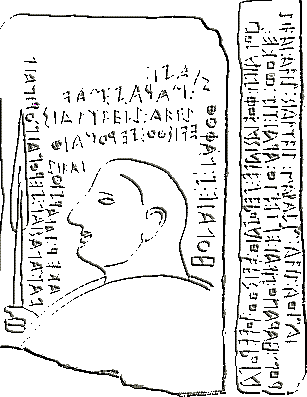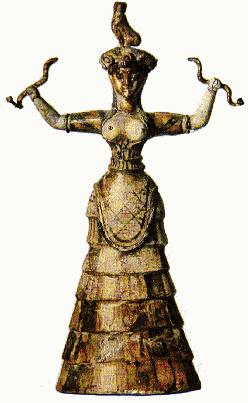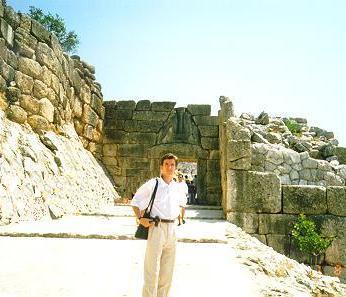§ 1.
The Unique Region.
This region was a cradle of all European civilization. First states
on European land appeared here, on islands of the East Mediterranean, when
territories of modern Britain, Germany and Russia were still inhabited
by tribes who hardly new primitive land cultivation and horse breeding
and lived mainly by hunting and constant nomadic migrations. When there
was no Rome, and its famous seven hills even did not see any Italics; when
Athens did not hear a single Greek word - the first Europeans who created
a state, built a capital with palaces, villas, temples, built sea fleets
and established overseas trade, prospered here on Crete.
Occasionally, when we tried to gather ore material about the history of peoples of East Mediterranean, we noticed that no scientist places here the place of origin of any people: they all came from somewhere to settle on Mediterranean shores. Egyptians came from the south, following the Nile; Jews, Phoenicians and other Semitic nations appeared here, as we believe, from the Arab peninsula; Indo-Europeans were born in deep Asia and migrated here rather late. But what is surprising is the number of different ethnic and language groups which emerged here for centuries in the past, came and disappeared, mixed with other peoples, and still remained in history. Ancient works of historians, Homerus's poetry, geographical descriptions of the region contains about 60 different names of tribes who lived along the coast of the Mediterranean sea from Balkans to Palestine, and they must have represented various language families, and possibly even different races.
In due time, after all fertile lands of Mediterranean islands and shores became inhabited, the historical events follow each other, more and more interesting and important for the whole human civilization history. The Egyptian Empire becomes the dominating power here first; then the Hittite kingdom comes into power, widening its influence through all Asia Minor, then Syria and Palestine; appearance of the Minoan Kingdom on Crete who begin to rule the sea with its trading activities; the famous Egyptian - Hittite treaty follows, and in a few centuries a new power emerges: "Sea Peoples" crush the Hittite civilization, invade Egypt, settle on Crete and in Asia Minor. Then Cretan and Mycenaean kingdoms - the civilized people first enter the European continent.
We will try to describe those few languages we found in various sources;
they were spoken several millenniums ago on European lands and on islands
of the Aegean and Mediterranean seas, and soon disappeared. Inscriptions
are found, scripts were studied thoroughly, cities were excavated from
the earth - but we still cannot translate them and say with sure who were
they, speakers of Mediterranean languages. Versions suggested here are
not the only ones - it is impossible to include plenty of them, so please
do not be offended if a theory you support is not proven true. Let us take
them all into consideration.
§ 2. Peoples and
Languages of Asia Minor.
When Hittites, first Indo-European wave who separated from the Proto-Indo-European
community and began migrating to the West, arrived to Asia Minor, they
met there quite a lot of different tribes of various languages and origins.
Hatti (or Proto-Hittites) were, probably a Caucasian nation who gave its
name, its cities and lands to Hittites, picked up their language, loaning
to it a great number of words. In a few centuries Hittites acquired vocabulary,
which since then was just 20% Indo-European. All religious terms, personal
names and place names, even many phonetic and morphological peculiarities
of Hittite became completely non-Indo-European.
Hittites broadened their influence to the whole Asia Minor, and left
many historical documents describing other tribes and towns of the peninsula
and neighbouring lands.

This map represents names of countries and nations mentioned in Hittite
and Luwian sources. The region inhabited by Indo-European Hittite, Luwian,
Palaic people, is painted pink.
Most of the names on this map are gone in history, and peoples or regions are unknown. Even the exact place of their existence is not obvious. But still there are some of these, which can be traced back. It is known from Greek sources that the Mediterranean shores of Asia Minor were inhabited by different peoples, whose origin was unknown by Greeks. Some think Pelasgians, pre-Hellenic population of Greece, came from Asia Minor, whether they were Indo-Europeans or not. The word Assuwa mentioned in Hittite sources, is the same as Greek Asia, that's how Asia got its name. Another name for the people of Asia Minor is Ahhijawa which is for sure Achaeans, Greeks who are believed to settle on Asian coasts already since the 15th century BC. Later, when Hittites began migrating westwards, Lycia, Lydia and Caria were invaded by Anatolian-speaking peoples, Achaeans were made to go back to Aegean Islands and to Balkans. But before that Ahhijawa is considered as one of the famous "Sea Peoples" who meant the decline of the Hittite Kingdom.
Most ancient place names of West Asia Minor carry some Caucasian accent. Hatti, Hurrians, sometimes even Palaic people are thought to have been of Caucasian language family. But there is no doubt that these peoples migrated further west, from Asia to Europe.
Egyptian manuscripts also mention infamous Sea Peoples as the major sea power in East Mediterranean. The most valuable source of linguistic information from Ancient Egypt is the list of names for Sea Peoples. Different versions and theories were generated from these names, we will name several of them here. Sherdana, a people who, probably, lived in West Asia Minor or on some islands in the Aegean Sea, is sometimes found relative to the city of Sardis, future capital of Lydia, a Hittite-descended region in Asia Minor. Really, Anatolians were fond of preserving ancient names of cities and countries: Hattusa, Pala, Arzawa kept their pre-Hittite names for ages, the same would go with Sardis. Another theory, more fantastic, equals Sherdanna and Sardis with Sardes on the island of Sardinia. The pre-Roman population there spoke a language also unrelated to Indo-European, sooner Iberian or maybe Etruscan. If future scientists are able to discover some links of Asia Minor with Sardinia, some migrations or contacts, this theory will gain more supporters. And now this only means two non-Indo-European languages with similar names, and there were quite a lot of such examples in the history: Hatti in Asia and a Germanic tribe Hatti; Picts in Scotland and Pictones in Aquitane, Venetians in North Italy and Venedes, the name for Slavs used by ancient Germanic tribes.
Another co-incidence or relic is the name Shakalasha also from the Egyptian list. Again, one of the ancient cities in later region of Lycia was called Sagalassa. In the sixth century BC it was occupied by Lycians, descendants of Indo-European Luwians, but in the 13th century, when Egypt was full of fear of Sea Peoples, it was surely a city of some other people, not Hittite - Egyptians never mention Hittites as one of the Sea Peoples. Lycians just settled on these lands, but preserved names of towns as well as the name of the very country - Lukka in Hittite sources.
One more strange fact: the name Tursha is sometimes analyzed
as a variant of Tyrsena, or Tyrrhena, that's
how Greeks called Etruscans who lived in Central Italy five hundred years
later than Sea Peoples acted in the Nile Delta. Already Herodot, followed
by Xenophon and Strabo, stated that Etruscans, originally Pelasgians, came
from Asia Minor via the Balkan Peninsula. Indeed, some linguists (Georgiyev)
find parallels between Asia Minor languages, Pelasgian and Etruscan. We
already wrote about the Pelasgian problem and the famous stele from the
island of Lemnos, written in an alphabet similar to Etruscan. This is another
sign of the possible waves of migration to the west from Asia Minor that
took place in ancient times. Many linguists believe Greece was invaded
by first Indo-Europeans (Achaeans - Ahhijawa) also from Asia
across the Aegean Sea. But that is the question for the next paragraph.
§ 3. Peoples and
Languages of the Aegean Islands.
The well known Cyclades culture represented peoples we do not know,
and therefore their languages remain unknown. It looks like this archaeological
culture had little contact with Egypt and Middle East, for practically
no art technique was borrowed from those higher levels of civilization,
and no remnants of Egyptian or Syrian presence were found here on the Cyclade
islands.
Later, in the beginning of the 2nd millennium BC, the Aegean region became the crossroads of numerous trade ways and ways of migrations. A huge earthquake on the island of Fera, which might cause great geographical and climate changes on the islands, made many peoples migrate seeking for better lands. People living in Crete and Cyprus began building their settlements farther from the dangerous sea which could invade every moment.
This epoch (2000 - 1500 BC) Late Minoan culture prospered on Crete, developing trade and cultural ties with Egypt, Asia Minor, Palestine; Achaeans crossed the sea and started settling in Greece, when in Argolis their culture called Mycenaean was the first civilization on the continent. Writing was introduced, and from different historical and archaeological sources we now have some info about exact languages of the period which dominated on the Aegean islands.
 Lemnian,
known by the famous stele, was spoken on the island of Lemnos up to the
fifth century. Greeks persistently stated that Lemnos was inhabited by
Pelasgians, and we can admit this. Anyway, their existence here took place
already in the 16th century. The structure of the language remains unknown,
because we have only one document written in it - the very stele. Written
in a variant of the Western Greek
Lemnian,
known by the famous stele, was spoken on the island of Lemnos up to the
fifth century. Greeks persistently stated that Lemnos was inhabited by
Pelasgians, and we can admit this. Anyway, their existence here took place
already in the 16th century. The structure of the language remains unknown,
because we have only one document written in it - the very stele. Written
in a variant of the Western Greek
alphabet, it is still very badly understood but seems to be close to
Etruscan and Rhaetian (which are supposed relatives as well). These three
languages are united by several signs: the noun ending -s'
in Rhaetian and Lemnian, -sl in all three, verb endings -eis',
-s'i, -ai, -aith, -ke / -ake. Their meanings are not understood,
but usage is similar. Lexical parallels are also of some number: avs'
(Lemnian a year), avil (Etruscan a year), nafoth
(Lemnian a nephew), nefs (Etruscan a nephew).
Lemnian contacted with Greek, and words borrowed by Greeks from it include
opuiein (to marry, compare with Etruscan puia
- a wife).
The next language is Eteo-Cretan, spoken on the island of Crete, in the middle period of the Minoan civilization. We have many administrative documents in this language, but we are not able to read them. They are all written in a specific script called Linear A (the ancestor of Linear B) which is still undeciphered. We can however have an idea of the language for several reasons: First, the Linear script was borrowed by Greeks to write in their tongue, with the Linear B form. But the Linear B suited rather badly for Greek, an Indo-European language, so we can assume that it reflected the phonetics of Eteo-Cretan which was not Indo-European and more Caucasian or even Semitic. The phonetics is also surprisingly close to Etruscan (no difference between voiced and voiceless consonants, between l and r and hesitation between l and d - this mutation was common among many Mediterranean languages and sometimes was borrowed into Latin - see Initial Mutations in Indo-European Languages).
Second, we have an Eteo-Cretan sentence designed as such in an Egyptian
papyrus (around 1500 BC), but unfortunately there is no word separation
there and it lacks vowels. The text is sometimes read as such : santi
kuppap waya yaya minti tekakali. What it means, we don't know but
can believe it is not Indo-European.
Third, the language was sometimes written in the Greek alphabet around
600 BC in Praisios. There too, there is no word separation. Here is an
example of such inscriptions: onadesiemetepimitspha dphnalaraphraisoiinai
retsnmtorsardophsano satoisstephesiamun animestepalungutat ....
So writing in the Greek alphabet does not add anything to its deciphering.
 Fourth,
linear A looks much like Linear B, which can be read, and if we apply it
to Cretan inscription, we can guess some words, so kur or
kul probably meant whole (the two are perhaps related,
as the English word whole comes from Proto-Indo-European *kwol-).
If this version is right, Eteo-Cretan could borrow the word from Indo-European
tongues. Another word asasara is probably a divine name.
Fourth,
linear A looks much like Linear B, which can be read, and if we apply it
to Cretan inscription, we can guess some words, so kur or
kul probably meant whole (the two are perhaps related,
as the English word whole comes from Proto-Indo-European *kwol-).
If this version is right, Eteo-Cretan could borrow the word from Indo-European
tongues. Another word asasara is probably a divine name.
The next language is Eteo-Cypriot, spoken on the island of Cyprus up
to the fourth century BC. It is mainly known from tablets from Enkomi,
which were written in a variant of the Linear A, but in most tablets the
script is very far evoluted. Unfortunately, they remain undeciphered as
well. We have, however, eight short inscriptions in the local Cypriot tongue
written int the fourth century using the local syllabic script. One is
partially bilingual : ana matori umiesaimukulailasana arisitonose
aratovanakasokoose kerakeretulosetakanaku (?) no (?) soli alo kailipolo.
The greek text reads: he polis he Amathousion Aristona Aristonaktos
Eupatriden. The phonetics of Eteo-Cypryot is sometimes considered
also related to Etruscan, but nothing more can be discovered yet.
§ 4. Peoples and Languages of Ancient Continental Greece.
Greek authors were sure that the first who inhabited their country were Pelasgians, who still existed in the 5th century BC and lived in Thessalia, on the island of Lemnos, in several towns of Epyrus and Peloponnese. But modern linguists came to the conclusion that Pelasgian was not the autochtonic language of the peninsula. Greeks came to these lands and met pre-Indo-European population who worshipped chthonic gods (first of all the Ground) were short and black-haired, and spoke an unknown language. Gea, the goddess of the ground, was supposedly borrowed from those peoples, who might have survived as eilótes, a sort of aborigine slaves in Sparta. Here Indo-Europeans introduced their favourite social structure - castes. Aryans in India established caste system to separate higher castes (Aryans) from lower ones (aboriginal population). Doric tribes who conquered Peloponnese did practically the same: divided all people into three social groups by origin: Lakedaimonioi (Doric people, who had all civil rights), Perioikoi (limited civil rights, probably Achaean population, relative to Doric), and Eilótes (autochtonic population, almost slaves). There are several signs in Ancient Greek works which show that eilotes spoke to each other in another language dissimilar to Greek.
 This
language is called Pre-Hellenic. No words or inscriptions are known from
it, except several placenames in Greece. It was proposed to explain the
presence in Greek of placenames in -thos or -ssos,
which exist also on islands of the Aegean and on Crete. Korinthos,
Tirinthos, Knossos are of this very sort. These endings are also
present also in many Greek words of unknown origin, some of them are probably
Cretan by origin (labyrinthos, asaminthos, narkissos).
This
language is called Pre-Hellenic. No words or inscriptions are known from
it, except several placenames in Greece. It was proposed to explain the
presence in Greek of placenames in -thos or -ssos,
which exist also on islands of the Aegean and on Crete. Korinthos,
Tirinthos, Knossos are of this very sort. These endings are also
present also in many Greek words of unknown origin, some of them are probably
Cretan by origin (labyrinthos, asaminthos, narkissos).
The opinion of the scholars about Pre-Hellenic is that this particular language was spoken in the Aegean area and in southern Italy. This language had obvious links with ancient Asia Minor and even Anatolian languages (mainly the use of placenames ending in -nd), but there is no consensus upon the interpretation among the scholars.
The only thing we can be sure of is that Pre-Hellenic, like Aegean and
many Asia Minor languages (Lemnian, Eteo-Cypriot, Eteo-Cretan) were remnants
of an old pre-Indo-European language complex, far related to Indo-European,
but not a part
of the family (probably linked with the expansion of agrarian economy
along the coast of Mediterranean around 5000 BC), and of which Etruscan
and Rhaetian could be later offsprings.
Anyway, Mediterranean languages, whether they represented the same linguistic community or different language families, was the whole stratum in European geo-linguistic history. As they were spoken in the epoch which is too far away from our time, and were completely assimilated by later Indo-European expansion, very little is known about them, and all versions about their origin, links between them and their relation to the Indo-European family itself remain just theoretical. But there is no doubt that Indo-Europeans were not the first in Europe, and there was substratum everywhere, not only in Greek or Italic, but also in Germanic, Celtic, Slavic languages. And it could not but influence Indo-European newcomers, so this is the history of languages of our ancestors, too.